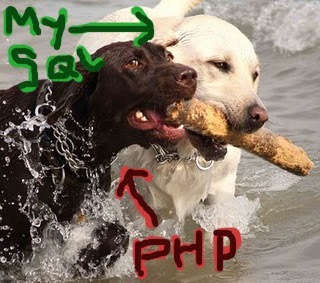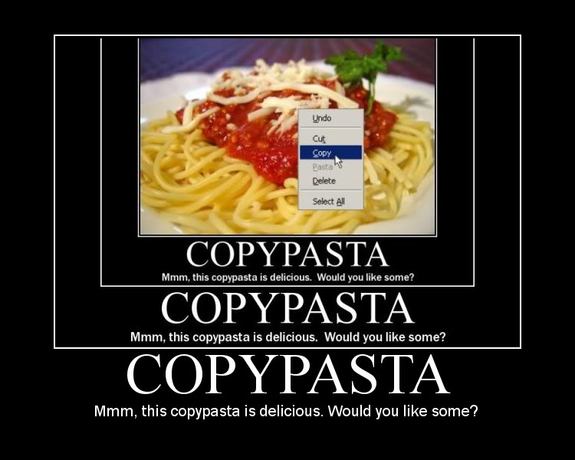Database-Backed PHP Apps
These day we rarely code a complex PHP application that does not make use of a database for back-end data storage. For this course we will be using the MySQL database as our database back-end.
Table of Contents
- Introduction
- Objectives
- Setting Up Our Tables
- SQL User Administration
- PHP Data Objects
- PDO Connect
- Connect Error Handling
- PDO Database Statements
- PDO SELECT
- Fetch All
- PDO WHERE
- PDO WHERE With User Data
- PDO WHERE With User Data
- PDO INSERT
- PDO UPDATE
- PDO DELETE
- Binding a Hash to a Statement
- Advanced PDO Topics
- Google Coding AKA Copypasta
Introduction

PHP and MySQL play very nicely together. In this module you will be using the PHP Data Objects extension (PDO) to connect your PHP scripts to a MySQL database.
PHP + MySQL = Best Friends Forever!
Objectives
By the end of this module, you will be able to:
- Establish a connection to a MySQL database from your PHP scripts.
- Use this connection to execute SQL queries on your database tables.
- Using SQL you will be able to perform the following tasks on your tables:
- C - Create
- R - Read
- U - Update
- D - Delete
Setting Up Our Tables

All the database tables we use in this class must contain a column named id. This id column should be:
- An INT of size 11.
- Auto-incrementing.
- The table’s primary key.
This column allows us to uniquely identify any row of any table by number.
SQL User Administration
Ensure that the MySQL server is by logging into PHPMyAdmin. We will now configure a MySQL user that we will use for all our course work:
From the PHPMyAdmin SQL tab execute:
CREATE DATABASE serverside;
CREATE USER 'serveruser'@'localhost' IDENTIFIED BY 'gorgonzola7!';
GRANT SELECT, INSERT, UPDATE, DELETE, CREATE, DROP, ALTER
ON serverside.* TO 'serveruser'@'localhost';
PHP Data Objects
The PHP Data Objects extension (PDO) allows you to access the functionality provided by a SQL server in an object-oriented manner.
Provided by the PDO extension is the MySQL Driver which represents a connection between PHP and a MySQL database. By changing the PDO Driver you can switch between different types of database servers.
Remember: In PHP object methods are called using the stabby operator -> as follows:
$favourite_noun->the_best_method_in_the_world($coolest_parameter_evar);
Assuming we’ve already instantiated an object called $favourite_noun.
Resources
PDO Connect
Before a PHP script can query a MySQL database it must connect to the database server by creating an PDO object.
<?php
define('DB_DSN','mysql:host=localhost;dbname=serverside;charset=utf8');
define('DB_USER','serveruser');
define('DB_PASS','gorgonzola7!');
// Create a PDO object called $db.
$db = new PDO(DB_DSN, DB_USER, DB_PASS);
?>
Tips and Gotchas:
- The Data Source Name or DSN string can include an optional port number:
mysql:host=localhost;port=3307;dbname=serverside
Connect Error Handling
We can add error handing to the previous connection script using a try/catch block.
<?php
define('DB_DSN','mysql:host=localhost;dbname=serverside');
define('DB_USER','serveruser');
define('DB_PASS','gorgonzola7!');
try {
$db = new PDO(DB_DSN, DB_USER, DB_PASS);
} catch (PDOException $e) {
print "Error: " . $e->getMessage();
die(); // Force execution to stop on errors.
}
?>
Tips and Gotchas:
- When deploying an application to production you would likely want to handle the catching of db errors more gracefully, rather than just calling
die.
Resources
PDO Database Statements
SQL queries are submitted as strings to the PDO object.
<?php
$query = "INSERT INTO quotes (author, content) values ('Wally Glutton', 'Learn to Question')";
$statement = $db->prepare($query);
$statement->execute();
?>
Tips and Gotchas:
- The above code assumes that we have already created a PDO object called
$db.
Resources
PDO SELECT
A select statement is used to select rows from a table.
<?php
$query = "SELECT * FROM quotes";
$statement = $db->prepare($query); // Returns a PDOStatement object.
$statement->execute(); // The query is now executed.
?>
Below in the HTML we can loop through the retrieved rows:
<h1>Found <?= $statement->rowCount() ?> Rows</h1>
<ul>
<?php while ($row = $statement->fetch()): ?>
<li><?= $row['author'] ?> said <?= $row['content'] ?></li>
<?php endwhile ?>
</ul>
Tips and Gotchas:
- Each
$rowis an associative array with the retrieved column names as keys. - Selection can specify a comma delimited list of columns, instead of simple the “*” wildcard.
Resources
Fetch All
After selecting rows from a table you can retrieve an array of all the rows using the fetchAll() method, rather than fetching row by row from the statement.
<?php
$query = "SELECT * FROM quotes";
$statement = $db->prepare($query); // Returns a PDOStatement object.
$statement->execute(); // The query is now executed.
$quotes= $statement->fetchAll();
?>
Below in the HTML we can loop through the retrieved rows:
<ul>
<?php foreach($quotes as $quote): ?>
<li><?= $quote['author'] ?> said <?= $quote['content'] ?></li>
<?php endforeach ?>
</ul>
Tips and Gotchas:
- Just like with
fetchthe rows in the array returned byfetchAllare associative arrays with column names as keys.
Resources
PDO WHERE
A WHERE clause can be added to any select statement to enforce conditions on the returned rows. The WHERE clause takes the form:
WHERE condition1 [AND/OR] condition2 [AND/OR] condition3...
The conditions specify a column name, an operator, and a comparison value.
<?php
$query = "SELECT * FROM quotes WHERE id > 7";
$statement = $db->prepare($query);
$statement->execute();
?>
Tips and Gotchas:
- Where clauses can also be added to UPDATE and DELETE statements.
- Interpolating user data directly into a WHERE clause can be a security issue. We will guard against this on the next slide using parameterize queries.
PDO WHERE With User Data
Imagine we wanted to include some user data in one of our SQL queries. Perhaps we wish to load a specific row from a table based on an id provided as a GET parameter.
The naive solution would be:
<?php
$query = "SELECT * FROM quotes WHERE id = {$_GET['id']}"; // DANGER! DANGER!
$statement = $db->prepare($query);
$statement->execute();
?>
User data can never be trusted. In the above example we are injecting user data directly into our SQL which can lead to SQL Injection attacks. Please never do this.
Resources
PDO WHERE With User Data
The safe way to add user data to our SQL is to first sanitize the data and then use a parameterized SQL statement.
<?php
// Sanitize $_GET['id'] to ensure it's a number.
$id = filter_input(INPUT_GET, 'id', FILTER_SANITIZE_NUMBER_INT);
// Build a query using ":id" as a placeholder parameter.
$query = "SELECT * FROM quotes WHERE id = :id";
//the PDO::prepare function returns a PDOStatement object
$statement = $db->prepare($query);
// Bind the :id parameter in the query to the previously
// sanitized $id specifying a type of INT.
$statement->bindValue(':id', $id, PDO::PARAM_INT);
// Then execute the prepared statement.
$statement->execute();
?>
The sanitization of the id using filter_input in the above example may be overkill since bindValue when used with PDO::PARAM_INT should sanitize the parameter as an integer. However, it doesn’t really hurt to be too careful.
Resources
PDO INSERT
The insert statement is used to insert new rows into a specific table. The insert statement takes the form:
INSERT INTO table_name ( column1, column2,...columnN ) VALUES ( value1, value2,...valueN )
<?php
// Sanitize user input to escape HTML entities and filter out dangerous characters.
$author = filter_input(INPUT_POST, 'author', FILTER_SANITIZE_FULL_SPECIAL_CHARS);
$content = filter_input(INPUT_POST, 'content', FILTER_SANITIZE_FULL_SPECIAL_CHARS);
// Build the parameterized SQL query and bind sanitized values to the parameters
$query = "INSERT INTO quotes (author, content) values (:author, :content)";
$statement = $db->prepare($query);
$statement->bindValue(':author', $author);
$statement->bindValue(':content', $content);
// Execute the INSERT prepared statement.
$statement->execute();
// Determine the primary key of the inserted row.
$insert_id = $db->lastInsertId();
?>
Tips and Gotchas:
- When inserting user-supplied data be sure to sanitize it first using
filter_input. - The above code requires an HTML form to POST the author and content data.
Resources
PDO UPDATE
The update statement is used to modify existing rows in the database. One or more columns can be updated. The update statement has the form:
UPDATE table_name SET column1=new-value1, column2=new-value2 [WHERE Clause]
<?php
// Sanitize user input to escape HTML entities and filter out dangerous characters.
$author = filter_input(INPUT_POST, 'author', FILTER_SANITIZE_FULL_SPECIAL_CHARS);
$content = filter_input(INPUT_POST, 'content', FILTER_SANITIZE_FULL_SPECIAL_CHARS);
$id = filter_input(INPUT_POST, 'id', FILTER_SANITIZE_NUMBER_INT);
// Build the parameterized SQL query and bind the sanitized values to the parameters
$query = "UPDATE quotes SET author = :author, content = :content WHERE id = :id";
$statement = $db->prepare($query);
$statement->bindValue(':author', $author);
$statement->bindValue(':content', $content);
$statement->bindValue(':id', $id, PDO::PARAM_INT);
// Execute the INSERT.
$statement->execute();
?>
Tips and Gotchas:
- If no WHERE clause is specified all rows will be updated.
- To ensure that a WHERE clause can only affect a single row you can add
LIMIT 1to the end of your query. - The above code requires an HTML form to POST the author, content and id.
PDO DELETE
The delete statement is used to delete rows from a database table. The delete statement has the form:
DELETE FROM table_name [WHERE Clause]
<?php
$id = filter_input(INPUT_POST, 'id', FILTER_SANITIZE_NUMBER_INT);
$query = "DELETE FROM quotes WHERE id = :id";
$statement = $db->prepare($query);
$statement->bindValue(':id', $id, PDO::PARAM_INT);
$statement->execute();
?>
Tips and Gotchas:
- If no WHERE clause is specified all rows will be deleted.
- To ensure that only one row is deleted you can place
LIMIT 1at the end of your query. - The above code requires an HTML form to POST the id.
Binding a Hash to a Statement
Up to this point, if we had multiple parameters in a prepared statement we would have to make multiple calls to bindValue. However, we can bind multiple parameters using a hash.
<?php
$author = filter_input(INPUT_POST, 'author', FILTER_SANITIZE_FULL_SPECIAL_CHARS);
$content = filter_input(INPUT_POST, 'content', FILTER_SANITIZE_FULL_SPECIAL_CHARS);
$query = "INSERT INTO quotes (author, content) values (:author, :content)";
$statement = $db->prepare($query);
$bind_values = ['author' => $author, 'content' => $content];
$statement->execute($bind_values);
?>
Tips and Gotchas:
- The parameters in the query start with colons but the keys in the hash do not. The colon is optional in the hash keys.
Advanced PDO Topics
These notes cover the basics of using PDO with a MySQL database. Here are some links to more advanced topics:
- Example Advanced PDO Code (Written by a former student.)
- PDO Errors and Error Handling
- Database Transactions with PDO
Google Coding AKA Copypasta
In this course we are only using PDO for database access.
Be wary of example code you find online that uses the mysql or mysqli extensions.
Code written using the mysql and mysqli extensions will not be accepted for challenges or assignments.
If you wish to use a database abstraction other that PDO for you work, please ask for special permission from your instructor.
